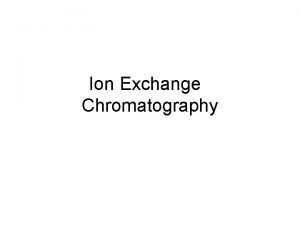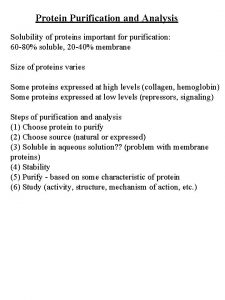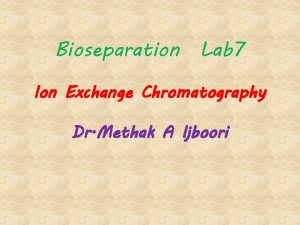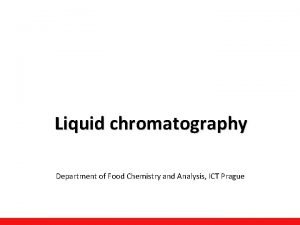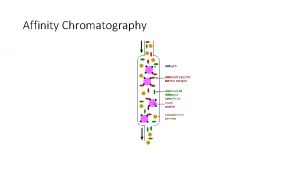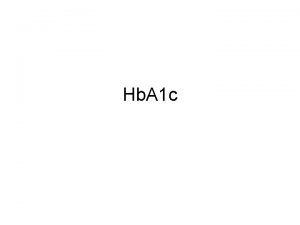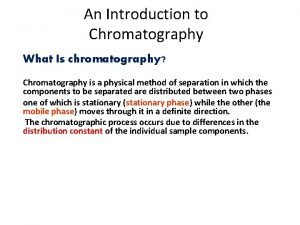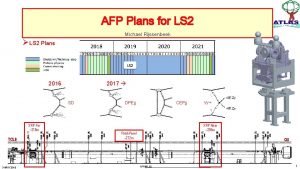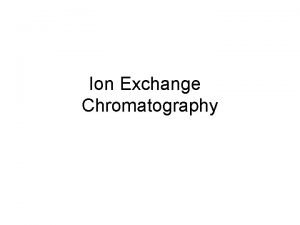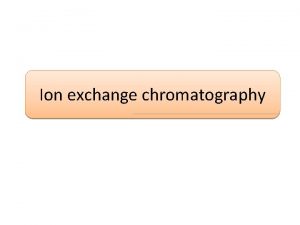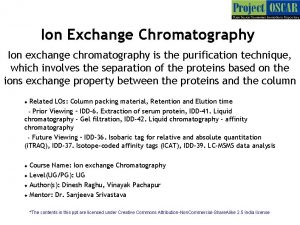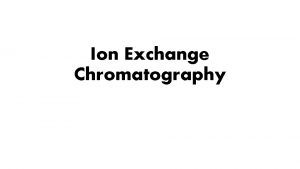Ion Exchange Chromatography Ion Exchange Chromatography Anion exchangers











- Slides: 11

Ion Exchange Chromatography

Ion Exchange Chromatography Anion exchangers They contain immobilized cationic groups that bind to anions. The most common: a matrix with attached diethylaminoethyl (DEAE), DEAE: matrix-CH 2 N+H(CH 2 CH 3) 2 Cation exchangers They contain immobilized anionic groups that bind to cations. e. g. a matrix with carboxymethyl group(CM) CM: matrix- CH 2 – COO-

• The matrix could be cellulose or agarose. • Proteins have negative or positive charges, so they can bind both exchangers.

The binding affinity of a protein depends on: 1. The presence of other ions that compete with the protein for binding to the ion exchanger. 2. the p. H of the solution which influences the net charge of the protein.

http: //higheredbcs. wiley. com/legacy/colleg • e/voet/0471214957/animated_figures/ch 05 /f 5 -5. html

Procedure • The mixture of the proteins is applied to the column. • The column is washed with the buffer. • The proteins with low affinity to the ion exchanger move faster than the proteins with higher affinity. • Proteins that bind tightly can be eluted by applying a buffer with a higher salt concentration or p. H that reduces the affinity.

• In this experiment two proteins( cytochrom c and myoglobin) will be separated by cation exchange chromatography using Sephadex C-25 resin with a 50 m. M sodium phosphate buffer at p. H 8.

• Under these conditions only one protein ( cytochrom) will become attached to the resin. The cytochrom will be attached to the cation exchanger because it is positive at p. H 8 since it's p. I = 10. 4 while the myoglobin's p. I= 7 so its negative (why? ). • To elute the cytochrom which is attached to the resin sodium chloride is added, the positive sodium ions will replace the cytochrom.

• Remove the buffer solution from the top of the resin bed using a Pasteur pipette and then very carefully add the sample. ( the sample is a mixture of myoglobin and cytochrome c). • 3. Wait for a while till the protein mixture enters the resin then open the screw clip. • 4. Immediately add the phosphate buffer (PH 8) and collect 2 ml fractions, collect the fractions until the first colored protein is fully eluted. • .

• 5. Keep the top of the resin covered with buffer at all times. • 6. Remove the buffer from the top of the resin and replace with Na. CL solution and continue collecting fractions until the second colored protein is fully eluted. • 9. Collect approximately 25 fractions. • 7. Read the absorbance at 400 nm using phosphate buffer as blank for the first protein and Nacl for the second protein.

• 8. Record all your results in a table • Draw a graph of the absorbance against the fraction number • Identify the resulting peaks
 Anion exchange chromatography
Anion exchange chromatography Slidetodoc. com
Slidetodoc. com Anion exchange chromatography elution order
Anion exchange chromatography elution order Protein chromatography
Protein chromatography Gfp purification flow chart
Gfp purification flow chart Ion exchange chromatography principle
Ion exchange chromatography principle Ion exchange chromatography
Ion exchange chromatography Affinity chromatography principle
Affinity chromatography principle Factors affecting ion exchange chromatography
Factors affecting ion exchange chromatography Introduction to chromatography
Introduction to chromatography Ddi heat exchangers
Ddi heat exchangers Rce heat exchangers
Rce heat exchangers

